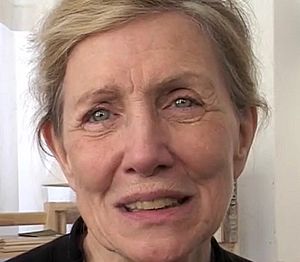Dorothea Rockburne facts for kids
Quick facts for kids
Dorothea Rockburne
|
|
|---|---|

Rockburne in Speaking Portraits
|
|
| Born | 1929 (age 95–96) Montreal, Quebec, Canada
|
| Education | Black Mountain College |
| Known for | Mathematician, Astronomer, Abstract Artist |
Dorothea Rockburne (born in 1929) is a Canadian artist. She creates abstract paintings. Her main ideas come from her strong interest in mathematics (the study of numbers and shapes) and astronomy (the study of stars and space). Her artwork uses geometric shapes and looks simple, but it is very precise. She wanted to show mathematical ideas in her art. She once said, "I wanted very much to see the equations I was studying, so I started making them in my studio." She was "visually solving equations" with her art.
Becoming an Artist
In 1950, Dorothea Rockburne moved to the United States. She went to Black Mountain College to study. There, she learned from a mathematician named Max Dehn. He had a big influence on her art for her whole life. She also studied with other famous artists and musicians like Franz Kline and John Cage. She even met another student, Robert Rauschenberg.
In 1955, Rockburne moved to New York City. She met many important artists and poets there. She was also inspired by the simple, modern dances of Yvonne Rainer and the Judson Dance Theater.

Throughout her career, she made paintings that showed mathematical ideas. In 1958, she had her own art show. It was very successful, but Rockburne felt her work was "not good enough." So, she did not show her art publicly again for over ten years. Instead, she focused on dance and performance art around 1960. She performed at the Judson Dance Theater and took ballet classes. During this time, she worked as a waitress and helped her friend Robert Rauschenberg in his studio to support her daughter, Christine.
By 1970, the Bykert Gallery in New York started showing her art again. This gallery also showed other famous artists like Chuck Close.
Exploring New Ideas
Dorothea Rockburne created a series of art installations called Set Theories. One piece, called Intersection, tried to combine two of her other artworks. This showed the mathematical idea of an "intersection," where two things meet or overlap. This series led her to try new ideas and materials, like gold leaf and carbon paper.
In 2011, a special exhibition of her work was shown at the Parrish Art Museum in New York. Then, in 2013, the Museum of Modern Art had a show just for her drawings.
Rockburne is a member of several important art groups. These include the American Academy of Arts and Letters and the National Academy of Design. In 2016, she earned a special doctorate degree from Bowdoin College. In 2009, she became an Honorary Vice President of the National Association of Women Artists. This was the first professional art group for women in the United States. She is also part of the American Abstract Artists.
In 2021, Rockburne's art was shown in an exhibition called Women in Abstraction at the Centre Pompidou in Paris.
Famous Artworks
Here are some of Dorothea Rockburne's well-known artworks:
- Fire Engine Red. Made in 1967. It uses wrinkle finish paint on aluminum. You can see it at the University of Michigan Museum of Art.
- Scalar. Made in 1971. This piece uses chipboard, crude oil, paper, and nails. It is at the Museum of Modern Art in New York.
- Locus. Made in 1972. This is a series of six relief etchings and aquatints on folded paper. It is also at the Museum of Modern Art in New York.
- Golden Section Painting #6. Made in 1975. It uses Kraft paper and blue pencil on linen. It is at the University of Michigan Museum of Art.
- Cosmic Moment, 1997. This is a reflection hologram. It is at the J. Paul Getty Museum.
- Triangle, 1978. Made with vellum paper, varnish, glue, and color pencil. It is at the Museum of Contemporary Art, Los Angeles.
- F.P.I. 19, 1973. This is a pen drawing on folded paper. It is at the Museum of Contemporary Art, Los Angeles.
- Robe Series, The Descent, 1976. Made with gesso, varnish, glue, and oil on linen. It is at the Philadelphia Museum of Art.
See also
 In Spanish: Dorothea Rockburne para niños
In Spanish: Dorothea Rockburne para niños

